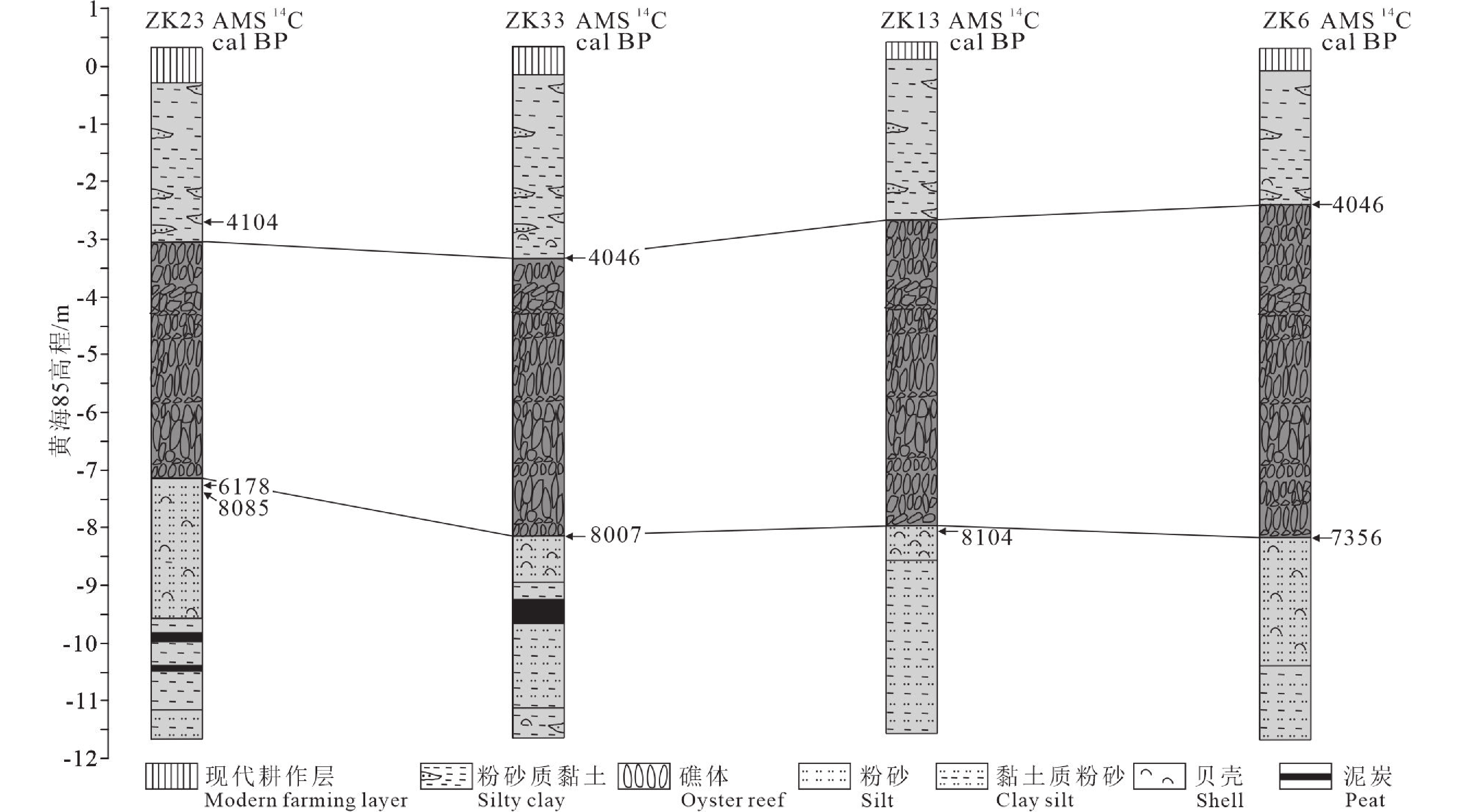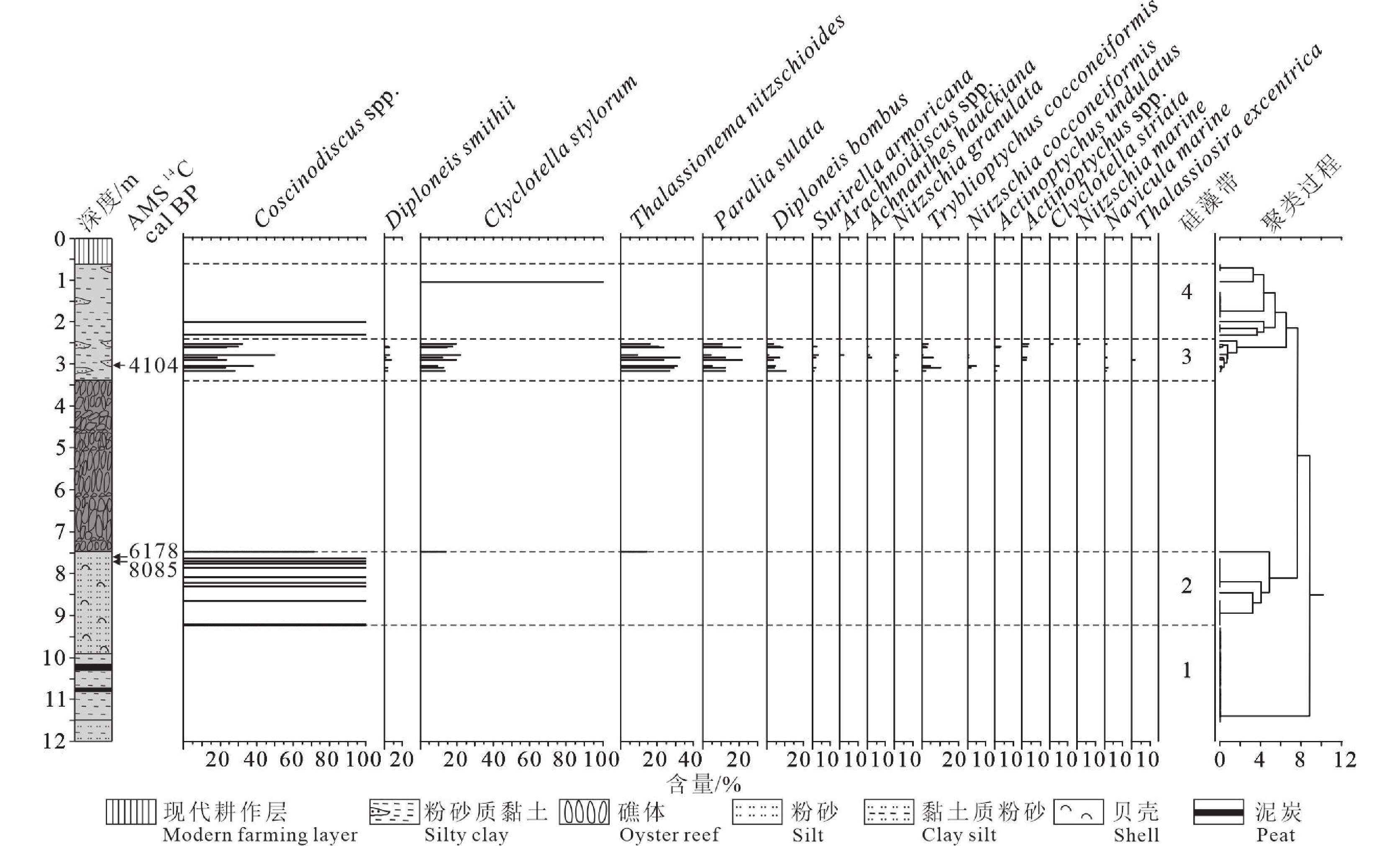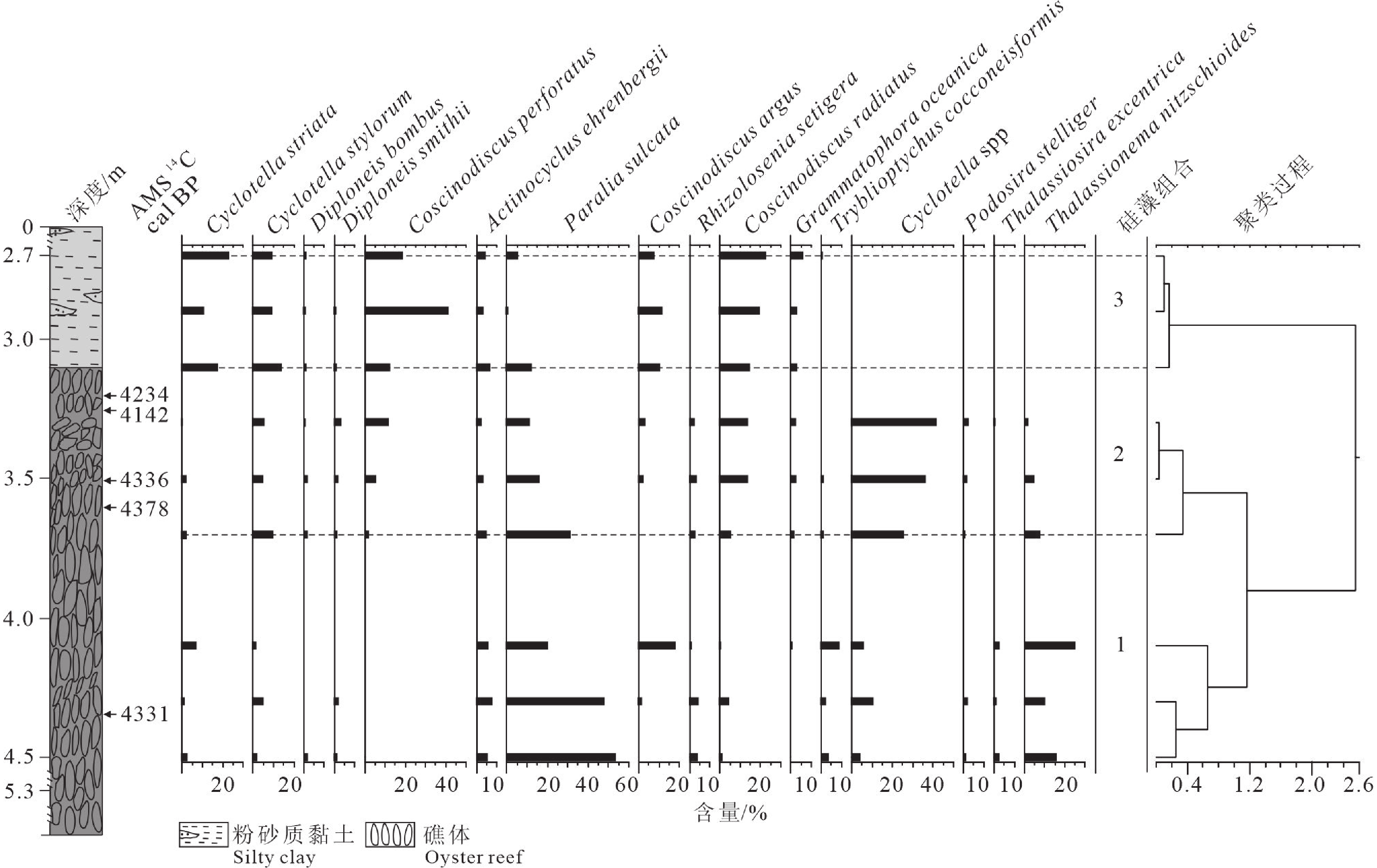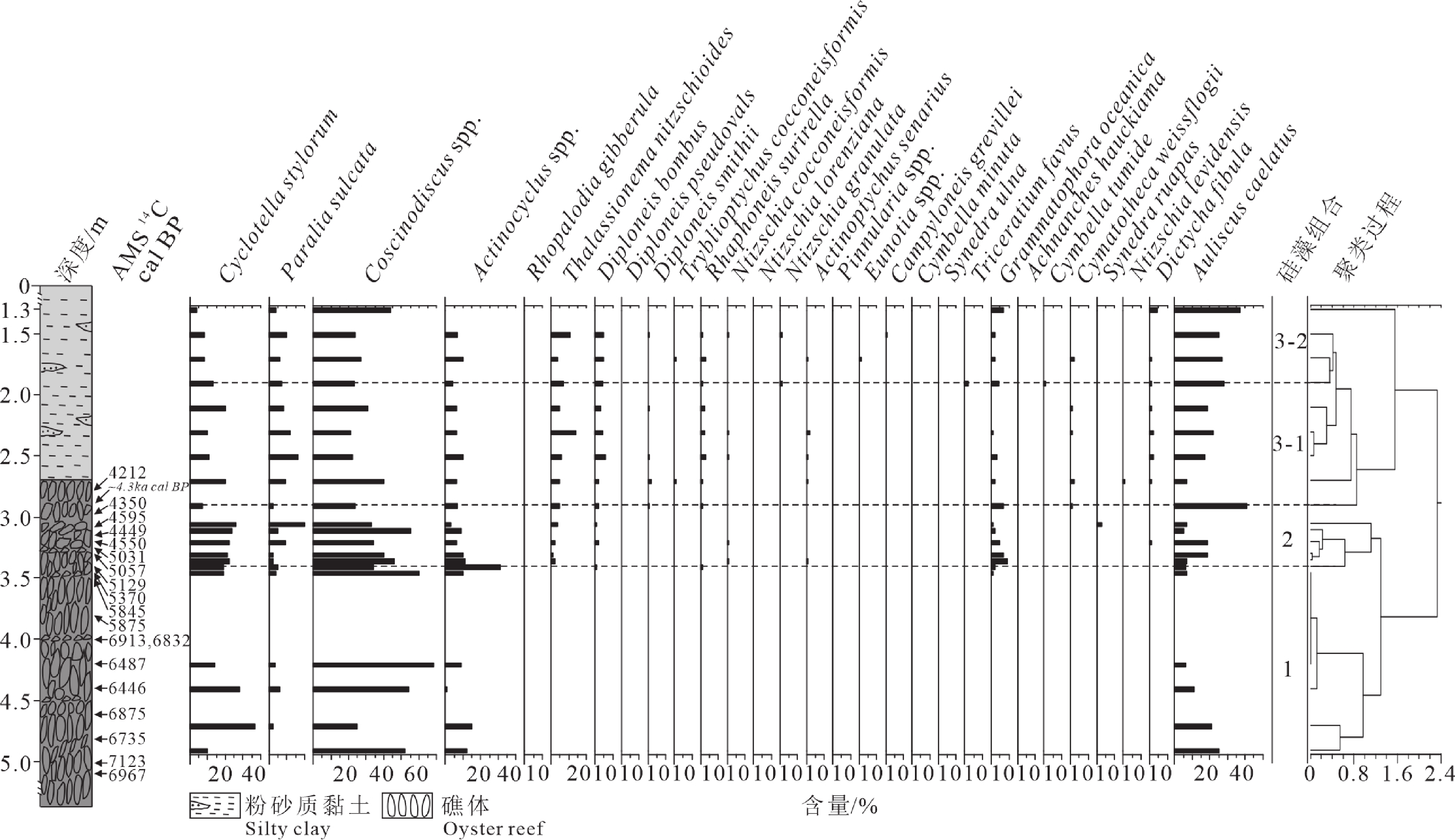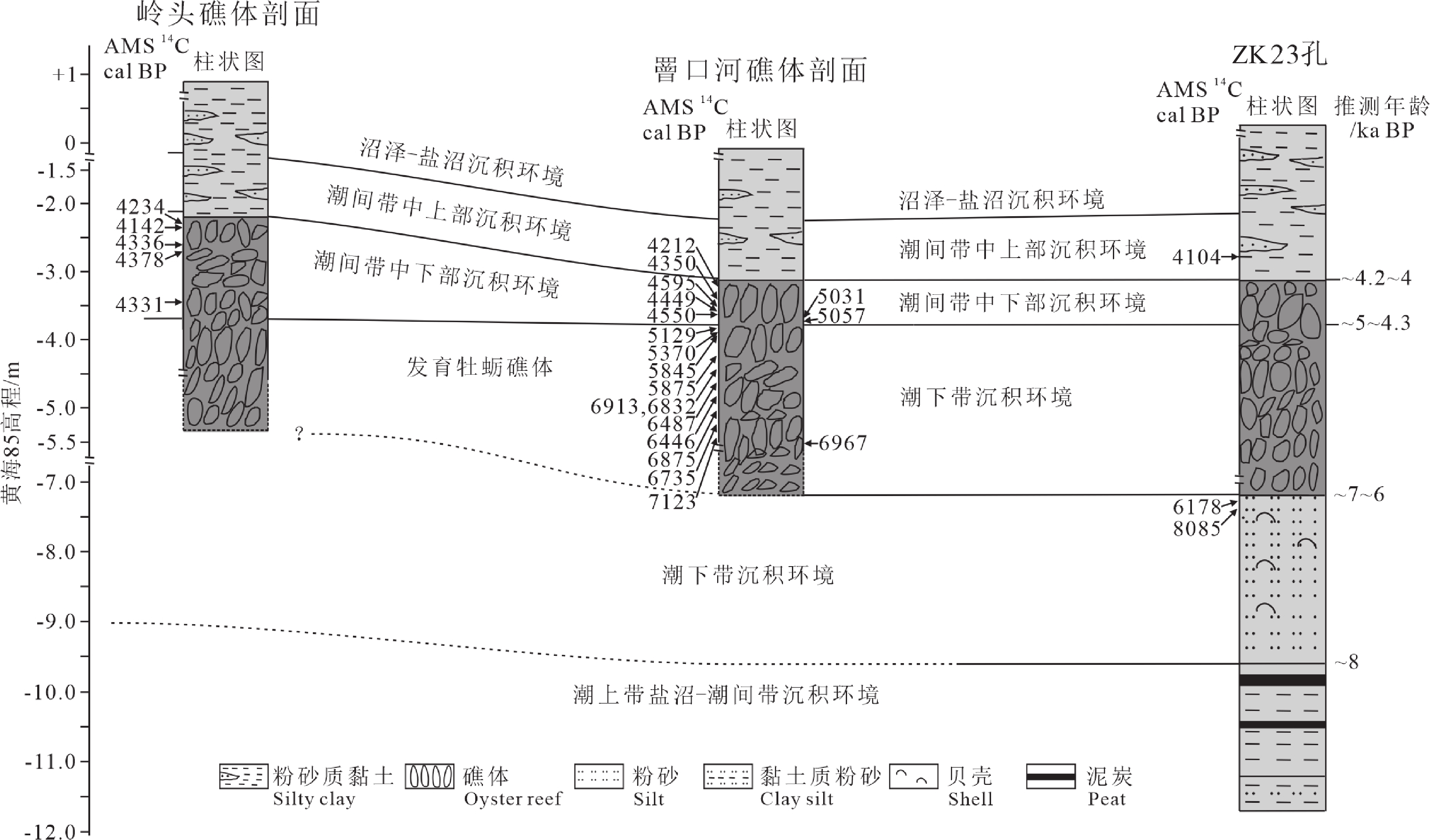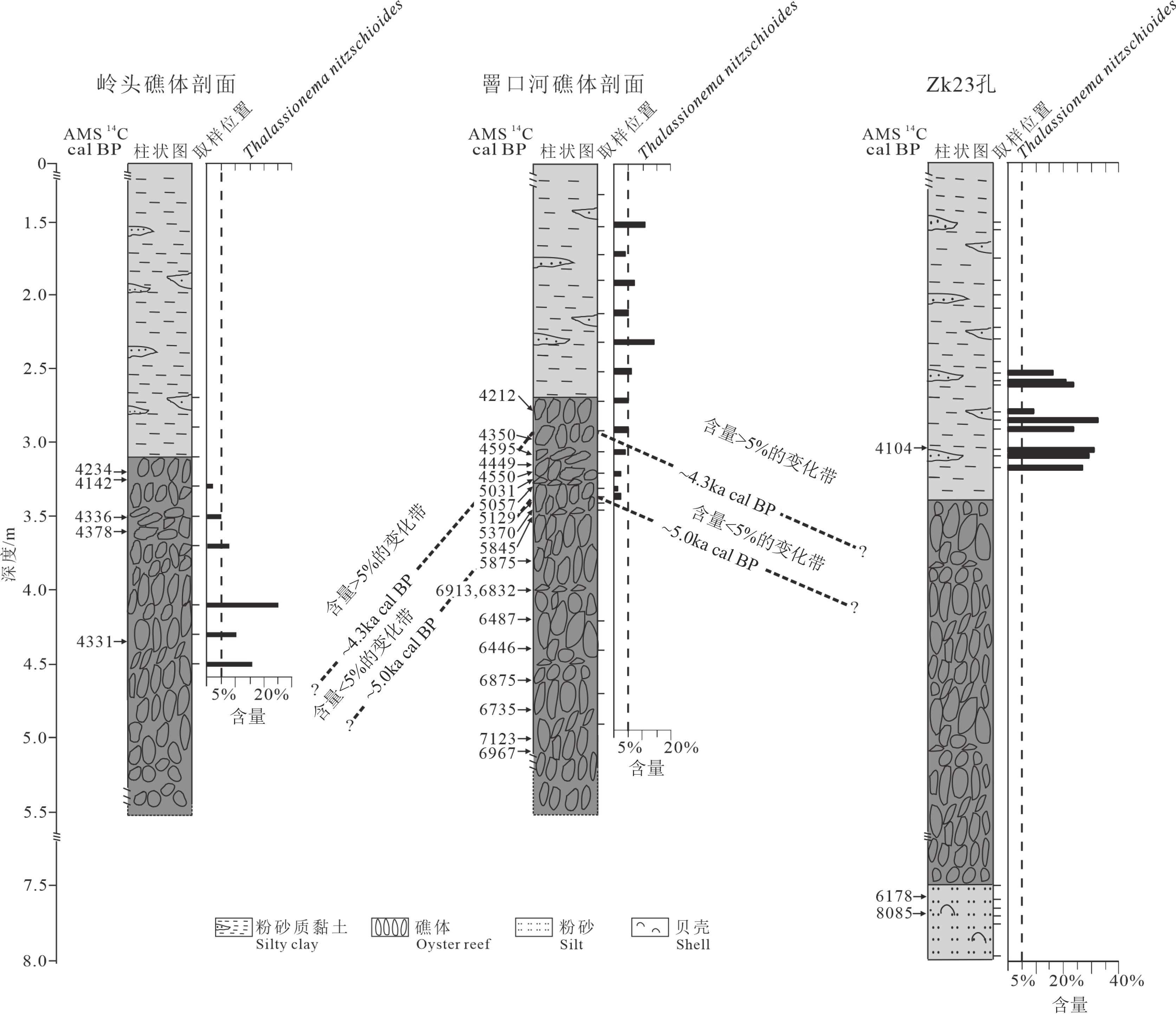Paleo−environment reconstruction of the oyster reefs around 4.2 ka BP in the North West Coast of Bohai Bay, China
-
摘要:
研究目的 越来越多的高分辨率古气候记录证实全新世存在一系列数十年至百年尺度的快速波动,而这种突然的气候变化与人类社会经济发展有着非常密切的关系。4.2 ka BP气候突变事件在亚洲、非洲、北美洲以及地中海和南欧等地均有记录,表明了它的全球性特征。但在海陆交互的海岸带、特别是中国北方泥质海岸带地区,该事件的记录迄今未得到充分证实。
研究方法 本文以渤海湾西北岸相距1~6 km的岭头、罾口河及俵口南部3处埋藏牡蛎礁体及其上覆泥层为研究对象,通过硅藻分析(83个样品)、加速器14C测年(32个数据)与沉积学研究,重建了礁体及上覆泥层所记录的古环境信息,同时探索了可能存在的“4.2 ka BP事件”在海岸带的印记。
研究结果 全新世以来,研究区依次经历了早全新世潮上带盐沼至潮间带→中全新世潮下带—潮间带中下部—潮间带中上部→晚全新世沼泽−盐沼低地沉积环境演变的海进−海退过程。在约7 ka cal BP以来,3处礁体先后出现,气候温暖。随着礁体的向上建造,海水影响减弱,在5~4.3 ka cal BP时,3处礁体进入潮间带中下部,气候相对寒冷,致使3处礁体同时在4.2~4 ka cal BP时停止建礁,随即被上覆泥层覆盖。
研究结论 研究区在5~4 ka cal BP发生了一次气候波动过程:5~4.3 ka cal BP期间相对寒冷,4.3 ka cal BP后逐渐转暖,气候变化事件的转折点发生于约4.3 ka cal BP。这一明显的环境变化是中国北方泥质海岸带地区对“4.2 ka BP事件”的响应。
Abstract:This paper is the result of coastal geological survey engineering.
Objective More and more high resolution paleoclimatic records confirm that a number of subcentennial climate abrupt change events were exit in the Holocene. Such abrupt climate change events had a very close relationship with the social and economic development of human. 4.2 ka BP event are recorded in Asia, North America, the Mediterranean, Southern Europe and other places which indicated that this event were global in extent. However, the record of this evnent has not been adequently substantiated in the coastal zone, especially in northern China muddy coastal zones.
Methods This paper focuses on three buried oyster reefs and their overlying mud layers located 1−6 km apart on the northwest coast of Bohai Bay, namely Lingtou, Zengkouhe and the sourthern part of Biaokou. Through diatom analysis (83 samples), AMS 14C dating (32 data) and sedimentological research, the environmental information recorded by the reefs and overlying mud layers was reconstructed, and the possible imprints of the ‘4.2 ka BP event’ in the coastal zone were discussed.
Results The study area experienced a transgression−regression environment evolution from upper tidal salt marsh to intertidal zone in the Early Holocene→subtidal zone to lower and middle part of intertidal zone to middle and upper part of intertidal zone in the Mid−Holocene→salt marsh lowlands in the Late Holocene. At about 7 ka cal BP ago, three reefs appeared one after another, and as the reefs build up, the influence of the seawater become weakened. At about 5−4.3 ka cal BP, the three reefs entered the lower and middle part of the intertidal zone, the climate became colder and lead the three reefs be buried at the same time of 4.2−4 ka cal BP and covered by the overlying mud immediately.
Conclusions A climate fluctuation process occurred during 5−4 ka cal BP in the study area. The climate became colder during 5−4.3 ka cal BP, and gradually warmed after 4.3 ka cal BP. The turning point of the climate change occurred at about 4.3 ka cal BP. We speculate that this climate fluctuation was probably a response to the ‘4.2 ka BP event’ in the north muddy coast of China.
-

-
图 4 岭头礁体剖面图与硅藻组合特征(据商志文等, 2010b修改)
Figure 4.
图 5 罾口河礁体剖面图与硅藻组合特征(据商志文等, 2013
1 修改)Figure 5.
表 1 俵口南部、岭头与罾口河牡蛎礁剖面AMS 14C测年结果
Table 1. AMS 14C dating results of south Biaokou, Lingtou and Zengkouhe oyster reefs
剖面 实验室编号 深度/m 测试物 惯用年龄/BP 14C校正年龄(2σ)/cal BP 备注 俵口南部
礁体Beta-525540 3.05 光滑河篮蛤 3890±30 4104(4286~3918) ZK23 Beta-525539 7.58 纵肋织纹螺 5580±30 6178(6285~6005) Beta-525537 7.70 纵肋织纹螺 7450±30 8085(8213~7949) Beta-525538 8.51 光滑河篮蛤 7470±30 8104(8252~7969) ZK13 Beta-525543 2.7 菲律宾蛤仔 3850±30 4046(4224~3875) ZK6 Beta-525544 8.5 光滑河篮蛤 6660±30 7356(7461~7244) Beta-525541 3.7 毛蚶 3850±30 4046(4224~3875) ZK33 Beta-525542 8.5 纹斑棱蛤 7370±30 8007(8153~7899) 岭头
礁体2000Y109 3.2~3.3 伴生梯蛤Trapezium liratum壳,文石 3916±108 4142(4471~3820) 商志文等, 2016 2000Y108 3.3~3.7 牡蛎Crassotrea gigas韧带及相邻的生长层,
原生方解石3980±30 4336(4651~3998) BA 110339 3.1~3.3 3980±30 4234(4404~4069) BA 110338 3.4~3.7 4090±35 4378(4550~4195) BA 110337 4.2~4.5 4055±30 4331(4494~4154) 罾口河
礁体BA 110317 2.8 牡蛎Crassotrea gigas韧带及相邻的生长层,
原生方解石3965±30 4212(4399~4047) BA 110318 3.0 4070±30 4350(4511~4172) BA 110319 3.1 4245±30 4595(4780~4430) BA 110320 3.15 4180±25 4499(4342~4697) BA 110321 3.2 4215±25 4550(4402~4770) BA 110322 3.25 4590±25 5031(4858~5230) BA 110323 3.3 4605±25 5057(4874~5246) BA 110325 3.4 4655±30 5129(4946~5291) BA 110326 3.45 4835±25 5370(5251~5523) BA 110327 3.5 5295±35 5845(5691~5985) BA 110328 3.8 5320±60 5875(6090~5682) BA 110329 4.0 6250±35 6913(6746~7099) BA 110330 4.0 6185±35 6832(6671~6985) BA 110331 4.2 5885±40 6487(6329~6640) BA 110332 4.4 5850±35 6446(6301~6598) BA 110333 4.6 6220±40 6875(6704~7062) BA 110334 4.8 6100±50 6735(6555~6915) BA 110335 5.0 6425±40 7123(6955~7260) BA 110336 5.1 6290±40 6967(7124~6796) -
[1] An C B, Tang L Y, Barton L, Chen F H. 2005. Climate change and cultural response around 4000 cal yr B. P. in the western part of Chinese Loess Plateau[J]. Quaternary Research, 63: 347−352. doi: 10.1016/j.yqres.2005.02.004
[2] Bond G C, Showers W, Cheseby M, Lotti R, Almasi P, de Menocal P, Priore P, Cullen H. 1997. A Pervasive millennial−scale cycle in North Atlantic Holocene and glacial climates[J]. Science, 278: 1257−1266. doi: 10.1126/science.278.5341.1257
[3] Cho A, Lim J, Kim Y, Ahn U S. 2022. Variability of East Asian winter monsoon during Middle–Late Holocene: A study based on a crater lake on Jeju Island, South Korea[J]. Palaeogeography, Palaeoclimatology, Palaeoecology, 603: 111193.
[4] Cullen H M, de Menocal P B, Hemming S, Hemming G, Brown F H, Guilderson T, Sirocko F. 2000. Climate change and the collapse of the Akkadian Empire: Evidence from the deep sea[J]. Geology, 28(4): 379−382. doi: 10.1130/0091-7613(2000)28<379:CCATCO>2.0.CO;2
[5] Freund H, Gerdes G, Streif H, Dellwig O, Watermann F. 2004. The indicative meaning of diatoms, pollen and botanical macrofossils for the reconstruction of palaeoenvironments and sea−level fluctuations along the coast of Lower Saxony, Germany[J]. Quaternary International, 112: 71−87. doi: 10.1016/S1040-6182(03)00066-1
[6] Fukumoto Y. 2011. Mid−late Holocene paoeoenvironment in Karako lowland, western Japan, inferred from diatom analysis[J]. Quaternary International, 230: 115−121. doi: 10.1016/j.quaint.2010.08.003
[7] Guo Yujie, Qian Shuben. 2003. Chinese Seaweed[M]. Beijing: Science Press, 1–493 (in Chinese).
[8] Hong Y T, Hong B, Lin Q H, Zhu Y X, Shibata Y, Hirota M, Uchida M, Leng X T, Jiang H B, Xu H, Wang H, Yi H. 2003. Correlation between Indian Ocean summer monsoon and North Atlantic climate during the Holocene[J]. Earth and Planetary Science Letter, 211: 371−380. doi: 10.1016/S0012-821X(03)00207-3
[9] Hong Y T, Hong B, Lin Q H, Shibata Y, Zhu Y X, Leng X T, Wang Y. 2009. Synchronous climate anomalies in the western North Pacific and North Atlantic regions during the last 14, 000 years[J]. Quaternary Science Reviews, 28: 840−849. doi: 10.1016/j.quascirev.2008.11.011
[10] Hofmann A M, Geist J, Nowotny L, Raeder U. 2020. Depth−distribution of lake benthic diatom assemblages in relation to light availability and substrate: Implications for paleolimnological studies[J]. Journal of Paleolimnology, 64: 315−334. doi: 10.1007/s10933-020-00139-9
[11] Huang Yue, Ran Lihua, Jiang Hui. 2006. Diatom from the South China Sea during the latest Pleistocene and their paleoenvironmental significance[J]. Marine Geology and Quaternary Geology, 26(4): 7−13 (in Chinese with English abstract).
[12] Jiang Hui. 1987. Environment alalysis of the common fossil diatoms from the sediments of the China Sea[J]. Journal of Integrative Plant Biology, 29(4): 440−448 (in Chinese with English abstract).
[13] Jiang Xingyu, Ma Hongwei, Li Yan, Yang Dawei, Li Jianfen, Shang Zhiwen, Wang Hong. 2022. Distinctive variations between slow−and−rapid−sedimentations and their different spatiotemporal distributions in the central and western part of coastal plain of Liaodong Bay since Late Pleistocene[J]. North China Geology, 45(3): 22−29 (in Chinese with English abstract).
[14] Jin Dexiang, Cheng Zhaodi, Lin Junmin, Liu Shicheng. 1982. Diatom of China Sea (I) [M]. Beijing: Marine Press, 1–323 (in Chinese).
[15] Kosugi M. 1988. Classification of living diatom assemblages as the indicator of environments, and its application to reconstruction of paleoenvironments[J]. The Quaternary Research, 27(1): 1–20 (in Japanese).
[16] Li Chao, Lan Dongzhao, Shi Xuefa, Fang Qi. 2004. Contrast study on Late Quaternary sedimentary diatoms between the Qkinawa trough and the East China Sea shelf[J]. Journal of Xiamen University (Natural Science), 43(6): 836−841 (in Chinese with English abstract).
[17] Li Dongling, Fan Changfu, Huang Yue, Jiang Hui, Wang Hong, Shang Zhiwen. 2009. Paleo−environmental reconstruction with diatom assemblages in the buried oyster reef on the northwest coast of the Bohai Bay during the Middle Holocene[J]. Marine Science Bulletin, 28(3): 22−27 (in Chinese with English abstract).
[18] Li Yanyong, Li Hongchun, Yuan Daoxian, Yang Yan, Wang Jianli, Wang Xinya, Li Junyun, Tan Jiaming, Zhang Meiliang, Lin Yushi. 2006. A 4500−year high−resolution climatic record from stalagmite in Xinya cave, Chongqing, China[J]. Carsologica Sinica, 25(2): 95−100 (in Chinese with English abstract).
[19] Lian Pengling, Fang Xiuqi. 2001. On the relationship between the development of pre−historical cultures and environmental change in the Daihai Lake Region, Inner Mongolia[J]. Geographical Research, 20(5): 623−627 (in Chinese with English abstract).
[20] Liu Tengfei. 2015. The Study of Environmental Factors on Population Growth and Interspecific Competition of Thalassionema nitzschioides under Laboratory Conditions[M]. Qingdao: Ocean University of China, 1–62 (in Chinese with English abstract).
[21] Liu Yuhui, Sun Xia, Guo Caiqing. 2013. Records of 4.2 ka BP Holocene event from China and its impact on ancient civilizations[J]. Geological Science and Technology Information, 32(1): 99−106 (in Chinese with English abstract).
[22] Liu S F, Shi X F, Liu Y G, Qiao S Q, Yang G, Fang X S, Wu Y H, Li C X, Li X Y, Zhu A M, Gao J J. 2010. Records of the East Asian winter monsoon from the mud area on the inner shelf of the East China Sea since the mid–Holocene[J]. Chinese Science Bulletin, 55(21): 2306−2314. doi: 10.1007/s11434-010-3215-3
[23] Masson−Delmotte V, Schultz M, Abe−Ouchi A, Beer J, Ganopolski A, González Rouco J F, Jansen E, Lambeck K, Luterbacher J, Naish T, Osborn T, Otto−Bliesner B, Quinn T, Ramesh R, Rojas M, Shao X, Timmermann A. 2013. Information from Paleoclimate Archives[C]//Climate Change, The Physical Science Basis, Contribution of Working Group I to the Fifth Assessment Report of the Intergovernmental Panel of Climate Change. Stocker T F, Qin D, Plattner G K, Tignor M, Allen S K, Boschung J, Nauels A, Xia Y, Bex V, Midgley P M. United Kingdom: Cambridge University Press, 383–464.
[24] Mayewski P A, Rohling E E, Stager J C, Karlen W, Maasch K A, Meeker L D, Meyerson E A, Gasse F, Kreveld S V, Holmgren K, Lee−Thorp J, Rosqvist G, Rack F, Staubwasser M, Schneider R R, Steig E J. 2004. Holocene climate variability[J]. Quaternary Research, 62: 243−255. doi: 10.1016/j.yqres.2004.07.001
[25] Perry C A, Hus K J. 2000. Geophysical, archeological, and historical evidence support a solar−output model for cliamte change[J]. Proceeding of the National Academy of Sciences, 97(23): 12433–12438.
[26] Qin Lei, Shang Zhiwen, Li Yong, Li Jianfen. 2017. Temporo and spatial distribution of the oyster reef in Biaokou to Zengkouhe area[J]. Geological Survey and Research, 40(4): 306−310 (in Chinese with English abstract).
[27] Ran Lihua, Jiang Hui, Knudsen K L, Eiríksson J. 2008. Mid−to late−Holocene paleoceanographic changes in the northern north Atlantic[J]. Marine Science Bulletin, 27(5): 39−46 (in Chinese with English abstract).
[28] Richard W, Battarbee. 1986. Diatom analysis, Handbook of Holocene Palaeoecology and Palaeohydrology[M]. New York: John Wiley and Sons Ltd, 527–570.
[29] Saegusa Y, Sugai T, Ogami T, Kashima K, Sasao E. 2011. Reconstruction of Holocene environmental changes in the Kiso−Ibi−Nagara compound river delta, Nobi Plain, central Japan, by diatom analyses of drilling cores[J]. Quaternary International, 230: 67−77. doi: 10.1016/j.quaint.2009.11.013
[30] Sato H, Okuno J, Nakada M. 2001. Holocene uplift derived from relative sea−level records along the coast of western Kobe, Japan[J]. Quaternary Science Reviews, 20: 1459−1474. doi: 10.1016/S0277-3791(01)00005-1
[31] Sato H, Okuno J, Katoh S. 2003. Holocene crustal movement along the coast of western Kobe and the 1995 Kobe Earthquake, Japan[J]. Quaternary Science Reviews, 22: 891−897. doi: 10.1016/S0277-3791(02)00251-2
[32] Shang Zhiwen, Tian Lizhu, Wang Hong, Fan Changfu, Pei Yandong, Wang Fu, Li Jianfen. 2010a. Holocene diatom assemblages, chronology and paleoenvironment of the borehole CH19 in the northwestern Bohai Bay, China[J]. Geological Bulletin of China, 29(5): 675−681 (in Chinese with English abstract).
[33] Shang Zhiwen, Fan Changfu, Li dangling, Tian Lizhu, Pei Yandong, Wang Fu, Wang Hong. 2010b. Revealing paleo−environment difference of two oyster reefs by diatom assemblages in the northwest coast of Bohai Bay[J]. Marine Geology and Quaternary Geology, 30(5): 33−39 (in Chinese with English abstract).
[34] Shang Zhiwen, Tian Lizhu, Wang Hong, Li Jianfen. 2012. Diatom assemblages from surficial sediments in north−central Bohai Bay and their implications for environments[J]. Geology in China, 39(4): 1099−1107 (in Chinese with English abstract).
[35] Shang Zhiwen, Tian Lizhu, Fan Changfu, Li Jianfen, Wang Fu, Jiang Xingyu, Wang Hong. 2016. A preliminary study of the 4.2 ka event along the coast of Bohai Bay[J]. Geological Bulletin of China, 35(10): 1614−1621 (in Chinese with English abstract).
[36] Shang Z W, Li J F, Freund H, Shi P X, Wang H. 2023. Quantitative relationship between surface sedimentary diatoms and water depth in North−Central Bohai Bay, China[J]. China Geology, 6(1): 61−69.
[37] Shang Z W, Li J F, Wang F, Wang H. 2024. The middle and late Holocene climate change in Bohai Bay revealed by diatom proxy[J]. Journal of Oceanology and Limnology, https://doi.org/10.1007/s00343−024−3187−9.
[38] Shen Hongyuan, Jian Yulian, Li Xusheng, Wu Jinglu, Wei Ling, Wang Pengling. 2006. Environmental change inferred from distribution of Rb and Sr in different grain size fractions from lacustrine sediments in Huangqihai lake, Inner Mongolia[J]. Acta Geographica Sinica, 61(11): 1208−1217 (in Chinese with English abstract).
[39] Southon J, Kashgarian M, Fontugne M, Metivier B, W−S Yim W. 2002. Marine reservoir corrections for the Indian Ocean and Southeast Asia[J]. Radiocarbon, 44: 167−180. doi: 10.1017/S0033822200064778
[40] Wang H, Hong Y T, Lin Q H, Hong B, Zhu Y X, Wang Y, Xu H. 2010. Response of humification degree to monsoon climate during the Holocene from Hongyuan peat bog, eastern Tibetan Plateau[J]. Palaeogeography, Palaeoclimatology, Palaeoecology, 286: 171–177.
[41] Wang Haifeng, Pei Yandong, Liu Huimin, Fan Changfu, Wang Hong. 2011. Holocene oyster reefs: Spatial and temporal distribution and sea level indicators in Bohai Bay[J]. Geological Bulletin of China, 30(9): 1396−1404 (in Chinese with English abstract).
[42] Wang Hong, Fan Changfu, Li Jianfen, Li Fenglin, Yan Yuzhong, Wang Yunsheng, Zhang Jinqi, Zhang Yufa. 2006. Holocene oyster reefs on the northwest coast of the Bohai Bay, China[J]. Geological Bulletin of China, 25(3): 315−331 (in Chinese with English abstract).
[43] Wang Hong. 2022. Barrier−island−and−lagoon characterized land formation in the Bohai Bay and its enlightenment to sustainability of coastal development[J]. North China Geology, 45(1): 1−17 (in Chinese with English abstract).
[44] Wang Kaifa, Jiang Hui. 1987. Diatom assemblages and their depositional environment in the Yellow Sea since the Late Pleistocene epoch[J]. Acta Sedimentologica Sinica, 5(1): 94−103 (in Chinese with English abstract).
[45] Wang Kaifa, Lu Jijun, Zheng Yulong. 1995. Late Quaternary pollen−diatom assemblages along Fujian seashore and their paleoenvironmental implications[J]. Acta Micropalaeontologica Sinica, 12(4): 388−397 (in Chinese with English abstract).
[46] Wang Kaifa, Zhi Chongyuan, Zheng Yulong, Wang Honggen. 2002a. The study on diatom of late Quaternary sediment in the continental margin of the East China Sea (Northern Fujian Member)[J]. Acta Sedimentologica Sinica, 20(1): 135−143 (in Chinese with English abstract).
[47] Wang Kaifa, Zheng Yulong, Zhi Chongyuan, Tao Minghua. 2002b. Study on diatoms from Holocene sediments in the south continental margin (Putian and Quanzhou areas) of the East China Sea[J]. Acta Palaeontologica Sinica, 41(2): 273−279 (in Chinese with English abstract).
[48] Wang Kaifa, Zhi Chongyuan, Tao Minghua. 2003. Discovery of diatoms and analysis of paleoenvironment of the Late Quaternary on the margin of East China Sea (section of south Zhejiang)[J]. Acta Micropalaeontologica Sinica, 20(4): 350−357 (in Chinese with English abstract).
[49] Wang Shaowu. 2011. Holocene Climate Change[M]. Beijing: Meteorological Press, 1–283 ( in Chinese).
[50] Wess H, Courty M A, Wetterstrom W, Guichard F, Senior L, Meadow R, Curnow A. 1993. The genesis and collapse of third millennium North Mesopotamian civilization[J]. Science, 261: 995−1004. doi: 10.1126/science.261.5124.995
[51] Xu H, Hong Y T, Lin Q H, Hong B, Jiang H B, Zhu Y X. 2002. Temperature variations in the past 6000 years inferred from δ18O of peat cellulose from Hongyuan, China[J]. Chinese Science Bulletin, 47(18): 1578−1584. doi: 10.1360/02tb9347
[52] Xu Jinghua. 1998. The sun, climate, famine and the great migration[J]. Science in China (Series D), 28(4): 366−384 (in Chinese).
[53] Yang Peng, Li Jianfen, Wang Fu, Hu Yunzhuang, Shi Baojia, Wang Wenyu, Wang Hong. 2023. Present situation and protection restoration suggestions on the natural oyster reefs in China[J]. Geology in China, 50(4): 1082−1092 (in Chinese with English abstract).
[54] Yi S, Saito Y, Zhao Q H, Wang P. 2003. Vegetation and climate changes in the Changjiang (Yangtze River) Delta, China, during the past 13, 000 years inferred from pollen records[J]. Quaternary Science Reviews, 22: 1501−1519. doi: 10.1016/S0277-3791(03)00080-5
[55] Zhang Meiliang, Lin Yushi, Zhu Xiaoyan, Qin Jiaming, Yang Yan, Luo Guirong. 2006. The records of climatic change from a stalagmite during the late time of the Middle Holocene in Ninglang area, Yunnan[J]. Marine Geology and Quaternary Geology, 26(1): 35−40 (in Chinese with English abstract).
[56] Zhi Chongyuan, Wang Kaifa, Lan Dongzhao, Chen Chenghui, Zheng Yulong. 2003. Study on the relationship between diatom assemblage and paleoenvironment of the Late Quaternary in the Taiwan Channel and Xiamen island[J]. Acta Micropalaeontologica Sinica, 20(3): 244−252 (in Chinese with English abstract).
[57] Zhong Yan, Tian Hui, Zhang Jian, Zhang Kuo, Li Huaikun, Xiang Zhenqun. 2020. Progress and prospect of Neoproterozoic glaciations related researches on the Tarim Craton[J]. Geological Survey and Research, 43(2): 177−185 (in Chinese with English abstract).
[58] 郭玉洁, 钱树本. 2003. 中国海藻志[M]. 北京: 科学出版社, 1–493.
[59] 黄玥, 冉莉华, 蒋辉. 2006. 南海北部陆坡晚更新世末期硅藻及其古环境意义[J]. 海洋地质与第四纪地质, 26(4): 7−13.
[60] 蒋辉. 1987. 我国某些常见化石硅藻的环境分析[J]. 植物学报, 29(4): 440−448.
[61] 姜兴钰, 马宏伟, 李琰, 杨大炜, 李建芬, 商志文, 王宏. 2022. 辽东湾沿海平原中西部晚更新世以来低速、快速沉积的差别及其时空分布特征[J]. 华北地质, 45(3): 22−29.
[62] 金德祥, 程兆第, 林均民, 刘师成. 1982. 中国海洋底栖硅藻类(上)[M]. 北京: 海洋出版社, 1–323.
[63] 李超, 蓝东兆, 石学法, 方琦. 2004. 东海陆架与冲绳海漕晚第四纪沉积硅藻的对比研究[J]. 厦门大学学报(自然科学版), 43(6): 836−841.
[64] 李冬玲, 范昌福, 黄玥, 蒋辉, 王宏, 商志文. 2009. 渤海湾西北岸中全新世埋藏牡蛎礁的硅藻记录及古环境意义[J]. 海洋通报, 28(3): 22−27. doi: 10.3969/j.issn.1001-6392.2009.03.004
[65] 李延勇, 李红春, 袁道先, 杨琰, 王建力, 王昕亚, 李俊云, 覃嘉铭, 张美良, 林玉石. 2006. 重庆新崖洞XY6石笋4.5ka以来高分辨率δ18O、δ13C记录的气候变化[J]. 中国岩溶, 25(2): 95−100. doi: 10.3969/j.issn.1001-4810.2006.02.002
[66] 连鹏灵, 方修琦. 2001. 岱海地区原始农业文化的衰落与环境演变的关系[J]. 地理研究, 20(5): 623−627. doi: 10.3321/j.issn:1000-0585.2001.05.013
[67] 刘腾飞. 2015. 环境因子对菱形海线藻(Thalassionema nitzschioides)种群增长与种间竞争的影响研究[M]. 青岛: 中国海洋大学, 1–62.
[68] 刘浴辉, 孙霞, 郭彩青. 2013. 中国全新世4.2ka BP气候事件及其对古文明的影响[J]. 地质科技情报, 32(1): 99−106.
[69] 秦磊, 商志文, 李勇, 李建芬. 2017. 天津宁河俵口—罾口河牡蛎礁体时空分布[J]. 地质调查与研究, 40(4): 306−310.
[70] 冉莉华, 蒋辉, Knudsen K L, Eiríksson J. 2008. 北大西洋北部中全新世以来古海洋环境记录[J]. 海洋通报, 27(5): 39−46. doi: 10.3969/j.issn.1001-6392.2008.05.007
[71] 商志文, 田立柱, 王宏, 范昌福, 裴艳东, 王福, 李建芬. 2010a. 渤海湾西北部CH19孔全新统硅藻组合、年代学与古环境[J]. 地质通报, 29(5): 675−681.
[72] 商志文, 范昌福, 李冬玲, 田立柱, 裴艳东, 王福, 王宏. 2010b. 硅藻组合指示的渤海湾西北岸两个牡蛎礁体生长环境的差异[J]. 海洋地质与第四纪地质, 30(5): 33−39.
[73] 商志文, 田立柱, 王宏, 李建芬. 2012. 渤海湾中北部表层沉积硅藻分布及环境指示意义[J]. 中国地质, 39(4): 1099−1107. doi: 10.3969/j.issn.1000-3657.2012.04.027
[74] 商志文, 田立柱, 范昌福, 李建芬, 王福, 姜兴钰, 王宏. 2016. 渤海湾4.2 ka事件初步研究[J]. 地质通报, 35(10): 1614−1621. doi: 10.3969/j.issn.1671-2552.2016.10.008
[75] 申洪源, 贾玉连, 李徐生, 吴敬禄, 魏灵, 王朋岭. 2006. 内蒙古黄旗海不同粒级湖泊沉积物Rb、Sr组成与环境变化[J]. 地理学报, 61(11): 1208−1217. doi: 10.3321/j.issn:0375-5444.2006.11.010
[76] 王海峰, 裴艳东, 刘会敏, 范昌福, 王宏. 2011. 渤海湾全新世牡蛎礁: 时空分布和海面变化标志点[J]. 地质通报, 30(9): 1396−1404. doi: 10.3969/j.issn.1671-2552.2011.09.008
[77] 王宏, 范昌福, 李建芬, 李凤林, 阎玉忠, 王云生, 张金起, 张玉发. 2006. 渤海湾西北岸牡蛎礁研究概述[J]. 地质通报, 25(3): 315−331. doi: 10.3969/j.issn.1671-2552.2006.03.001
[78] 王宏. 2022. 渤海湾障壁岛—潟湖型成陆过程及对今后海岸带可持续发展的启示[J]. 华北地质, 45(1): 1−17.
[79] 王开发, 蒋辉. 1987. 黄海晚更新世以来的硅藻组合及其沉积环境[J]. 沉积学报, 5(1): 94−103.
[80] 王开发, 陆继军, 郑玉龙. 1995. 福建沿岸第四纪孢粉、硅藻组合及其古环境意义[J]. 微体古生物学报, 12(4): 388−397.
[81] 王开发, 支崇远, 郑玉龙, 王洪根. 2002a. 东海陆缘(闽北段)晚第四纪沉积的硅藻学研究[J]. 沉积学报, 20(1): 135−143.
[82] 王开发, 郑玉龙, 支崇远, 陶明华. 2002b. 东海南北陆缘(莆、泉段)全新世沉积硅藻[J]. 古生物学报, 41(2): 273−279.
[83] 王开发, 支崇远, 陶明华. 2003. 东海陆缘(浙南段)晚第四纪硅藻的发现及古环境分析[J]. 微体古生物学报, 20(4): 350−357. doi: 10.3969/j.issn.1000-0674.2003.04.003
[84] 王绍武. 2011. 全新世气候变化[M]. 北京: 气象出版社, 1–283.
[85] 许靖华. 1998. 太阳、气候、饥荒与民族大迁移[J]. 中国科学(D辑), 28(4): 366−384.
[86] 杨朋, 李建芬, 王福, 胡云壮, 石保佳, 王文宇, 王宏. 2023. 我国天然牡蛎礁现状及保护修复建议[J]. 中国地质, 50(4): 1082−1092.
[87] 张美良, 林玉石, 朱晓燕, 覃嘉铭, 杨琰, 罗贵荣. 2006. 云南宁蒗地区中全新世晚期气候变化的石笋记录[J]. 海洋地质与第四纪地质, 26(1): 35−40.
[88] 支崇远, 王开发, 蓝东兆, 陈承惠, 郑玉龙. 2003. 闽南第四纪晚期沉积硅藻组合与古环境研究[J]. 微体古生物学报, 20(3): 244−252. doi: 10.3969/j.issn.1000-0674.2003.03.003
[89] 钟焱, 田辉, 张健, 张阔, 李怀坤, 相振群. 2020. 塔里木陆块新元古代冰期事件研究进展与展望[J]. 地质调查与研究, 43(2): 177−185.
-



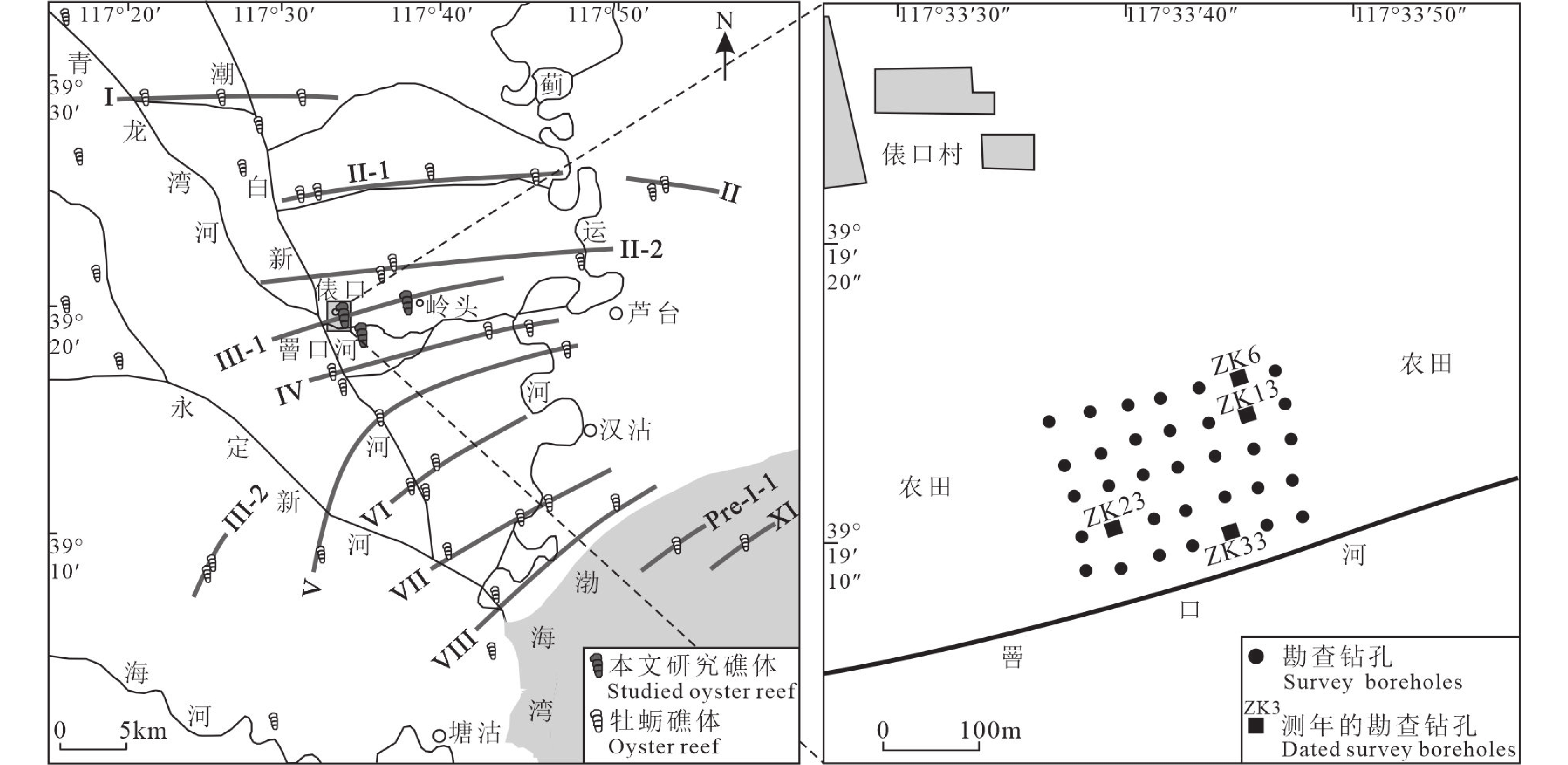
 下载:
下载:
